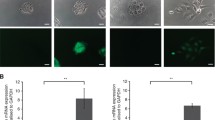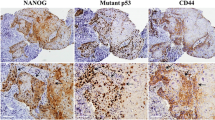Abstract
Sirtuins (SIRTs) are a family of proteins involved in the metabolic process responsible for extending the lifespan. The role of SIRT1, 6, and 7 in oral squamous cell carcinoma (OSCC) and oral leukoplakia (OLP), one of its precursors, is still elusive. In this study, 82 OLP and 77 OSCC were immunohistochemically examined for SIRT1, 6, and 7. Stained sections were thoroughly scanned and evaluated using a digital image analysis program. The SIRT1, 6, and 7 expressions were detected in the nuclei of epithelial and carcinoma cells in various degrees. Afterward, any correlations among SIRTs, including associations with clinicopathological features and the Kaplan–Meier curves were analyzed. OSCC demonstrated significantly higher SIRT1 expression than OLP, while non-dysplastic lesions showed significantly higher SIRT6 expression than other lesions. A strong correlation was observed between SIRT6 and 7 in OLP, SIRT1 and 6 in in OSCC and in SIRT6 and 7 when all lesion types were considered. There were no significant differences between SIRTs reactivity and the clinical features in OLP. For OSCC, SIRT1 and 6 was found to be directly associated with site of the lesion, while SIRT7 showed a direct relationship between gender, stromal lymphocytic infiltration, and depth of the invasion. OSCC with high SIRT7 expression revealed a slightly lower survival probability, although not statistically significant (p = 0.1019). Our findings suggest that SIRT1, 6, and 7 may play correlated and diverse roles in the development and advancement of OSCC.




Similar content being viewed by others
Change history
15 June 2023
A Correction to this paper has been published: https://doi.org/10.1007/s10266-023-00825-w
References
Johnson DE, Burtness B, Leemans CR, Lui VWY, Bauman JE, Grandis JR. Head and neck squamous cell carcinoma. Nat Rev Dis Prim [Internet]. 2020;6:92.
El-Naggar AK, JKC C, Grandis JR, Takata T, Grandis J, Slootweg P, editors. WHO classification of head and neck tumours. 4th ed. Lyon: IARC; 2017.
Markopoulos AK. Current aspects on oral squamous cell carcinoma. Open Dent J. 2012;6:126–30.
Warnakulasuriya S. Clinical features and presentation of oral potentially malignant disorders. Oral Surg Oral Med Oral Pathol Oral Radiol [Internet]. 2018;125:582–90.
Zhao L, Cao J, Hu K, He X, Yun D, Tong T, et al. Sirtuins and their biological relevance in aging and age-related diseases. Aging Dis. 2020;11:927–45.
Islam S, Abiko Y, Uehara O, Chiba I. Sirtuin 1 and oral cancer. Oncol Lett [Internet]. 2019;17:729–38.
Roth M, Chen WY. Sorting out functions of sirtuins in cancer. Oncogene [Internet]. 2014;33:1609–20.
Carafa V, Altucci L, Nebbioso A. Dual tumor suppressor and tumor promoter action of sirtuins in determining malignant phenotype. Front Pharmacol [Internet]. 2019;10:38.
Palmirotta R, Cives M, Della-Morte D, Capuani B, Lauro D, Guadagni F, et al. Sirtuins and cancer: Role in the epithelial-mesenchymal transition. Oxid Med Cell Longev [Internet]. 2016;2016:3031459.
Behnisch-Cornwell S, Grathwol CW, Schulig L, Voigt A, Baecker D, Link A, et al. Correlation analysis of protein expression of 10 HDAC/Sirtuin isoenzymes with sensitivities of 23 anticancer drugs in 17 cancer cell lines and potentiation of drug activity by co-treatment with HDAC inhibitors. Cancers (Basel) [Internet]. 2021;14:187.
Siril YJ, Kouketsu A, Oikawa M, Takahashi T, Kumamoto H. Immunohistochemical assessment of chromatin licensing and DNA replication factor 1, geminin, and gamma-H2A.X in oral epithelial precursor lesions and squamous cell carcinoma. J Oral Pathol Med [Internet]. 2019;48:888–96.
Brierley JD, Gospodarowickz MK, Wittekind C, editors. TNM classification of malignant tumours. 8th ed. Oxford: Wiley Blackwell; 2017.
Yamamoto E, Miyakawa A, Kohama G. Mode of invasion and lymph node metastasis in squamous cell carcinoma of the oral cavity. Head Neck Surg [Internet]. 1984;6:938–47.
Bankhead P, Loughrey MB, Fernandez JA, Dombrowski Y, McArt DG, Dunne PD, et al. QuPath: Open source software for digital pathology image analysis. Sci Rep [Internet]. 2017;7:16878.
Kaeberlein M, McVey M, Guarente L. The SIR2/3/4 complex and SIR2 alone promote longevity in Saccharomyces cerevisiae by two different mechanisms. Genes Dev. 1999;13:2580.
Tissenbaum HA, Guarente L. Increased dosage of a sir-2 gene extends lifespan in Caenorhabditis elegans. Nature. 2001;410:227.
Lee SH, Lee JH, Lee HY, Min KJ. Sirtuin signaling in cellular senescence and aging. BMB Rep. 2019;52:24–34.
Chen IC, Chiang WF, Huang HH, Chen PF, Shen YY, Chiang HC. Role of SIRT1 in regulation of epithelial-to-mesenchymal transition in oral squamous cell carcinoma metastasis. Mol Cancer [Internet]. 2014;13:254.
Kang YY, Sun FL, Zhang Y, Wang Z. SIRT1 acts as a potential tumor suppressor in oral squamous cell carcinoma. J Chin Med Assoc [Internet]. 2018;81:416–22.
Lu CT, Hsu CM, Lin PM, Lai CC, Lin HC, Yang CH, et al. The potential of SIRT6 and SIRT7 as circulating markers for head and neck squamous cell carcinoma. Anticancer Res [Internet]. 2014;34:7137–43.
Jia B, Zhang S, Wu S, Zhu Q, Li W. MiR-770 promotes oral squamous cell carcinoma migration and invasion by regulating the Sirt7/Smad4 pathway. IUBMB Life [Internet]. 2021;73:264–72.
Lai CC, Lin PM, Lin SF, Hsu CH, Lin HC, Hu ML, et al. Altered expression of SIRT gene family in head and neck squamous cell carcinoma. Tumour Biol [Internet]. 2013;34:1847–54.
Yoshii H, Sekihara K, Ideta Y, Nakajima S, Kato I, Okubo-Sato M, et al. The expression of SIRT6 is associated with treatment outcome in elder patients with oral cancer. Anticancer Res. 2022;42:3815–23.
Li W, Zhu D, Qin S. SIRT7 suppresses the epithelial-to-mesenchymal transition in oral squamous cell carcinoma metastasis by promoting SMAD4 deacetylation. J Exp Clin Cancer Res [Internet]. 2018;37:148.
Hu A, Huang JJ, Li RL, Lu ZY, Duan JL, Xu WH, et al. Curcumin as therapeutics for the treatment of head and neck squamous cell carcinoma by activating SIRT1. Sci Rep [Internet]. 2015;5:13429.
Islam S, Uehara O, Matsuoka H, Kuramitsu Y, Adhikari BR, Hiraki D, et al. DNA hypermethylation of sirtuin 1 (SIRT1) caused by betel quid chewing—a possible predictive biomarker for malignant transformation. Clin Epigenet. 2020;12:1–10.
Lee HJ, Auh QS, Lee YM, Kang SK, Chang SW, Lee DS, et al. Growth inhibition and apoptosis-inducing effects of cudraflavone B in human oral cancer cells via MAPK, NF-kappaB, and SIRT1 signaling pathway. Planta Med [Internet]. 2013;79:1298–306.
Murofushi T, Tsuda H, Mikami Y, Yamaguchi Y, Suzuki N. CAY10591, a SIRT1 activator, suppresses cell growth, invasion, and migration in gingival epithelial carcinoma cells. J Oral Sci [Internet]. 2017;59:415–23.
Park JJ, Hah YS, Ryu S, Cheon SY, Won SJ, Lee JS, et al. MDM2-dependent Sirt1 degradation is a prerequisite for Sirt6-mediated cell death in head and neck cancers. Exp Mol Med [Internet]. 2021;53:422–31.
Langsfeld ES, Bodily JM, Laimins LA. The deacetylase sirtuin 1 regulates human papillomavirus replication by modulating histone acetylation and recruitment of DNA damage factors NBS1 and Rad51 to viral genomes. PLOS Pathog. 2015;11:1–21.
Allison J, Jiang M, Milner J. Oncogenic viral protein HPV E7 up-regulates the SIRT1 longevity protein in human cervical cancer cells. Aging. 2009;1:316–27.
Kikuchi K, Noguchi A, Kasajima R, Miyagi Y, Hoshino D, Koshikawa N, et al. Association of SIRT1 and tumor suppressor gene TAp63 expression in head and neck squamous cell carcinoma. Tumour Biol [Internet]. 2015;36:7865–72.
Noguchi A, Li X, Kubota A, Kikuchi K, Kameda Y, Zheng H, et al. SIRT1 expression is associated with good prognosis for head and neck squamous cell carcinoma patients. Oral Surg Oral Med Oral Pathol Oral Radiol [Internet]. 2013;115:385–92.
Funding
None.
Author information
Authors and Affiliations
Corresponding author
Ethics declarations
Conflict of interest
None.
Ethical approval
The study protocol was reviewed and approved by the Research Ethics Committee of Tohoku University Graduate School of Dentistry (2020-3-043).
Patient consent
Written informed consent was obtained from all patients.
Additional information
Publisher's Note
Springer Nature remains neutral with regard to jurisdictional claims in published maps and institutional affiliations.
The original online version of this article was revised as bold style was missing in some significant values available in Table 1, 3 and corrected in this version. In addition, description of Table 1, 3 were incorrect and corrected now. Finally, statement regarding SIRT7 expression were incorrect under the section “Results”, “Discussion” and corrected in this version.
Rights and permissions
Springer Nature or its licensor (e.g. a society or other partner) holds exclusive rights to this article under a publishing agreement with the author(s) or other rightsholder(s); author self-archiving of the accepted manuscript version of this article is solely governed by the terms of such publishing agreement and applicable law.
About this article
Cite this article
Sripodok, P., Saito, H., Kouketsu, A. et al. Immunoexpression of SIRT1, 6, and 7 in oral leukoplakia and oral squamous cell carcinoma. Odontology 112, 221–229 (2024). https://doi.org/10.1007/s10266-023-00816-x
Received:
Accepted:
Published:
Issue Date:
DOI: https://doi.org/10.1007/s10266-023-00816-x




